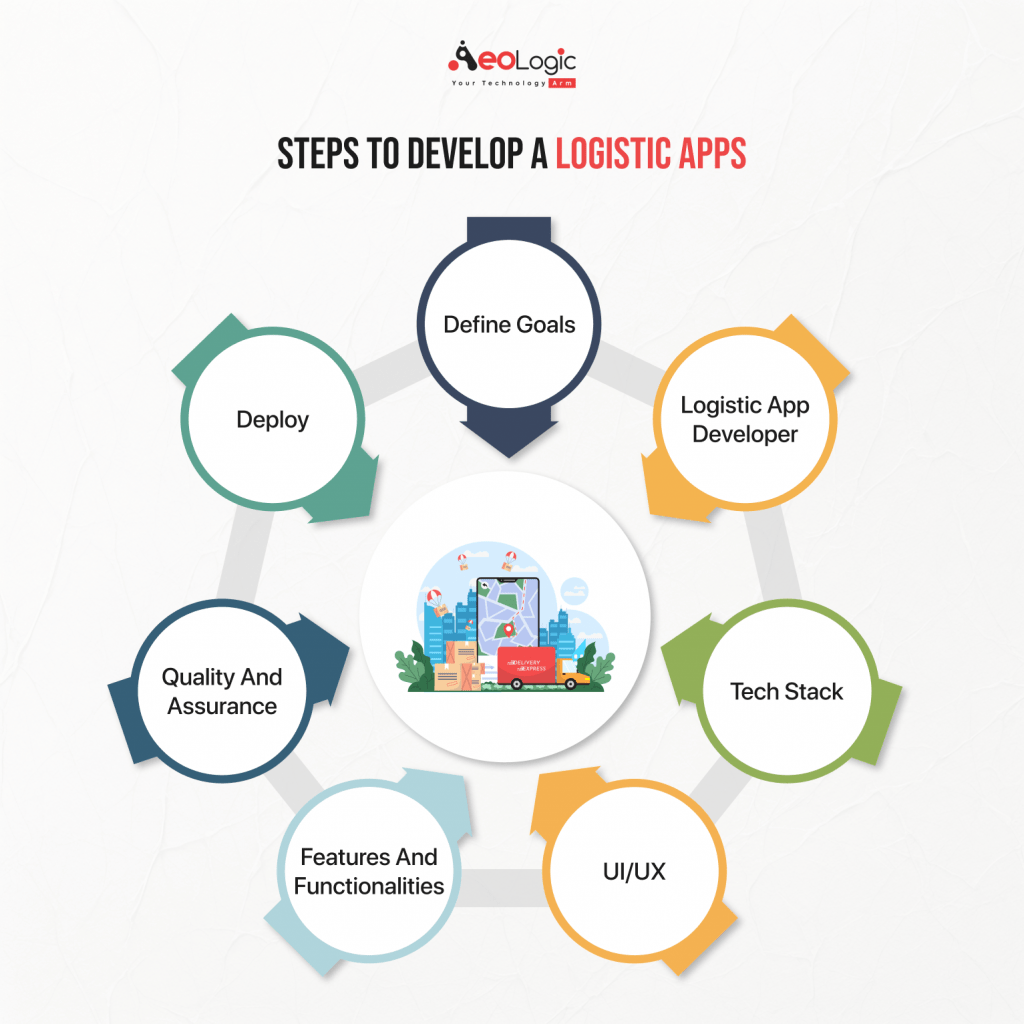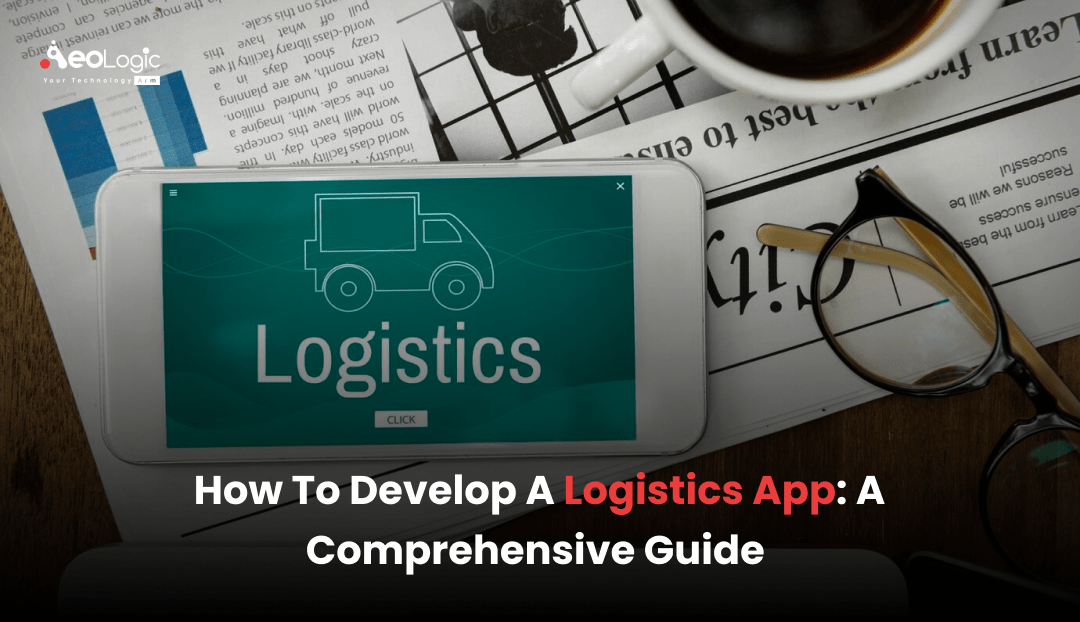The logistics industry is one of the main pillars across different industries and businesses that involves many processes in the supply chain. It holds the processes in the supply chain. Improper logistics operations lead to a loss in business and decrease the rate of productivity. But in today’s world, there is nothing that cannot be enhanced with technology as app development is a tool that can be very useful for the logistics industry. Even there are many apps present too that provide services to many organizations with positive results. The future of logistics app development is also looking impressive as here are some stats that can ensure it. In 2022, the market size of global logistics was valued at USD 83 billion, and by 2031, it is expected to grow by USD 33.17 billion. The entire growth of the supply chain market is growing at a CAGR of 9.36% during 2023-2031.
But it is not too easy to develop an app for the logistics industry and processes as it needs very detailed knowledge of the steps of development and other information about the logistics app development too. In this article, we will see the step-by-step guide about logistics app development and also will take a look at the features, challenges, etc of logistics app development.
What is Logistics App Development?
Generally, app development refers to the development of software for devices like phones, tablets, and desktops that provide services for any particular thing. Developing apps for tablets and phones is a step in the logistics app development process as these apps are also made to assist companies in planning and overseeing the movement of goods between locations. A logistics app provides facilities as a comprehensive solution that optimizes the movement of goods, enhances visibility across the supply chain, and facilitates effective communication among stakeholders.
How Does a Logistics App Work?
Mobile apps for logistics manage supply chains more effectively and help you keep an eye on truck spaces, warehouse statuses, location tracking, and other features using these apps. You can add an app to your workflow for logistics to make things more controlled and effective. When an order is placed then the app captures the information about the goods to be transported. Captured data then flows across different processes like inventory management, route optimization, shipment tracking, and more. An app for logistics management acts as a command center.
Also Read: Benefits of IT Solutions for Logistics Industry
Types Of Logistics Apps
Logistics apps have changed over time to meet the needs of the transportation and logistics business. They now do things like real-time tracking, inventory management, and more. Let’s look at the different kinds of logistics apps, each one designed to meet specific needs and make the whole supply chain environment more efficient and effective.
Real-Time Tracking Apps
A real-time tracking app is the best type of logistics app for your business if you want to keep users up to date on the location, state, and movement of goods in transit all the time. GPS and other complex technologies are used by this app to give you accurate, up-to-date information.
These apps make the logistics process more open, accurate, and quick by letting you track packages and make sure they arrive on time. It also lets the drivers share information like where they are, what the current delivery state is, and so on.
Delivery Apps
By making the delivery process more efficient and making sure goods get to their destinations quickly, delivery apps are all that companies need if their main service is shipping packages.
Other logistics apps focus on things like managing the whole supply chain or keeping track of goods. Delivery apps, on the other hand, are completely focused on the important last mile delivery (on-demand deliveries), which are different from scheduled deliveries. Real-time tracking and payment handling are some of the extra features that this app has to make things easier for users.
On-Demand Logistics Applications
The unusual logistics app, on the other hand, relied too much on physical work, wasn’t good at managing resources, and was especially disorganized when it came to providing customers with last-minute deliveries or urgent shipments.
It is best for businesses to use on-demand logistics apps so they can meet the changing needs of both customers and companies. No matter if it’s delivering packages, sharing rides for goods, or fast courier services, on-demand logistics apps make it easy to get quick and flexible logistics solutions.
Fleet Management Applications
Businesses, especially transportation companies, can’t run without their fleets. Because of this, business owners need to know everything about their fleets in real time. From the exact position of the vehicle right now to its fuel use, maintenance schedules, present condition, maintenance history, operating cost, maximum payload, and more, this information is available right away.
If logistics business owners had this knowledge on hand, they could increase productivity, cut costs, and make sure operations ran smoothly by making sure maintenance was done on time, finding the best routes, planning deliveries efficiently, and more.
Warehouse and Inventory Management Applications
As it’s meant to make tracking, organizing, and handling shipments and inventory in a supply chain easier, it can be thought of as a subset of a real-time tracking app. These apps usually have tracking, order processing, and inventory monitoring features that work in real time. They can do everything from keeping track of stock amounts to making sure that warehouse operations run smoothly.
These apps make it easier to manage big inventories by offering features like tracking in real time, scanning barcodes, and automatic order fulfillment.
Supply Chain Management Software
Supply chain management software makes sure that information flows smoothly through all of the links in the chain. This lets business owners keep an eye on and improve the whole chain, from buying things to distributing them. These apps are very useful because they let you keep track of your inventory, handle orders, see analytics in real time, and more.
These apps are made to fit the needs of businesses, making things more visible, speeding up processes, and eventually making logistics operations more efficient as a whole.
Also Read: Benefits of RFID in Supply Chain Management and Logistics
Key Features of a Logistic Apps
A logistics app brings too many features for businesses and organizations in terms of growth as here are a few features mentioned below.
Customer Side Features
Logistic app development allows many features for customers to manage their goods as they can schedule their transportation of goods, order tracking, tariff estimation, in-app communication with the driver and organization, address management, etc. All these facilities allow more enhancement in transportation and other logistics procedures.
Driver Side Features
There are also many features available for drivers as they can manage orders, route navigation, in-app communication to the customers, check-in and check-out, etc. This increases the efficiency of logistics management in any organization.
Admin Panel
The admin panel is the feature that acts as a control center for overseeing and managing the entire system. It enables the processing of many operations such as monitoring, maintaining, and controlling other logistics operations in a business organization.
Steps to Develop a Logistic Apps

To develop an app for logistics, there are a few steps needed to follow as it is not easy to develop a good app. Here are the necessary steps mentioned below.
- The first step is to define the goals, features, and type of app you need for your organization. This gives the idea for the next step as you will have proper knowledge about your destination.
- The next is to hire a logistic app development company as without a developer it cannot be possible to develop the app. It needs to get a good company that has good records on app development for logistics.
- The third step involves making the foundation of the app as it needs to decide the programming languages with go and other aspects such as detailing the technology requirements and infrastructure considerations that will ensure the seamless performance, scalability, and flexibility of your app.
- The fourth step is to design the UI/UX as the interface of the app should be user-friendly. It needs to hire a UI designer for this step.
- The fifth and most important step is to develop the core features and functionalities that you have decided during the first step. You can also hire a professional team of developers.
- Now it’s time to check the quality and assurance of the developed app before launching it on the official platform. This step ensures that the app is ready to deploy.
- The last step is to deploy the app on the desired platform and website. This also needs to be maintained from time to time in the app.
Trending Blog: The Benefits of RFID Every Retailer Should Know
Challenges with the Development of a Logistic Apps
As mentioned earlier, it is not easy to develop a logistic app. There can be some challenges to face as there are a few mentioned below.
- It is too costly to develop an app as it needs to hire a team of professional developers and others who charge too much fees. So it could be a concern for many.
- Sometimes it is very difficult to decide which features to include as there are a lot of users and it is not possible to put every feature according to every user.
- Data and privacy could also be a concern as the development of an app deals with data that sometimes could be a threat to security in the aspect of cyberattacks.
Final Words
Developing a logistics app facilitates effective management of warehouses and inventories, additionally, including a logistics app in business operations aids in the order tracking. Real-time tracking facilitates the tracking of shipments, cargo kinds, delivery schedules, and procedures. There can be some challenges in developing an app for logistics but surely it could be worth it after the development. Overall, if businesses, organizations, enterprises, etc need to be developed then they need to meet the requirements of this modern world that an app can fulfill.










